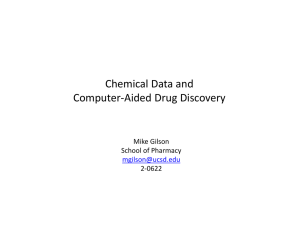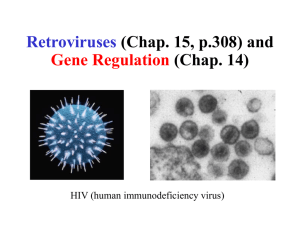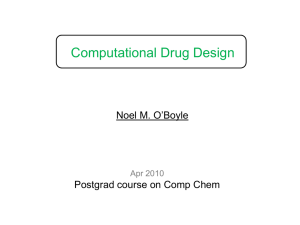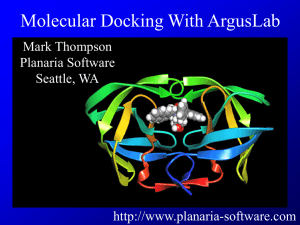Materials and Methods
advertisement
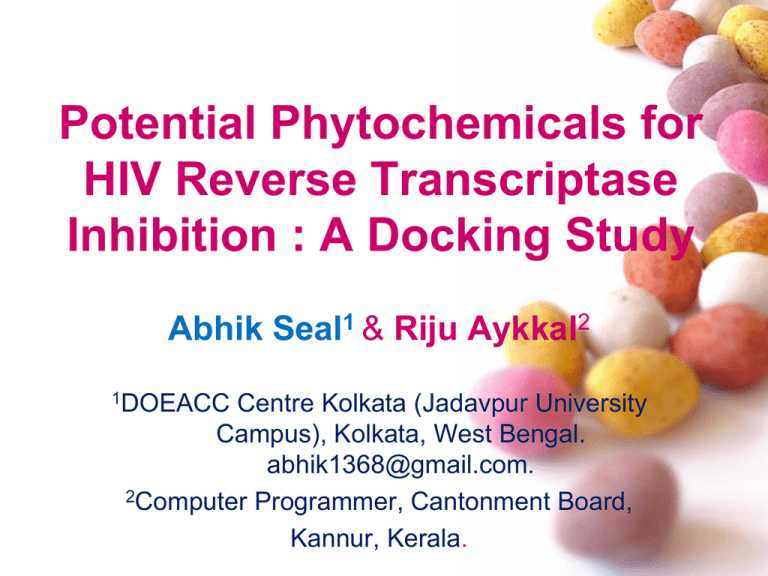
Potential Phytochemicals for HIV Reverse Transcriptase Inhibition : A Docking Study Abhik Seal1 & Riju Aykkal2 1DOEACC Centre Kolkata (Jadavpur University Campus), Kolkata, West Bengal. abhik1368@gmail.com. 2Computer Programmer, Cantonment Board, Kannur, Kerala. INTRODUCTION AIDS (acquired immunodeficiency syndrome), caused by the HIV (Human Immunodeficiency Virus), is one of the world’s leading causes of death with a major medical and economic impact on society. The enzyme reverse transcriptase (RT) is used by retroviruses to transcribe their single-stranded RNA genome into single-stranded DNA and to subsequently construct a complementary strand of DNA, providing a DNA double helix capable of integration into host cell chromosomes. # It is well know that replication can arrest by inhibiting the Reverse transcriptase enzyme. HIV-1 RT is a heterodimer, consisting of a p66 subunit with 560 amino acids and a p51 subunit with 440 amino acids. The two subunits form a stable dimer which is essential for the enzymatic activity. # Most of the combinatorial chemistry product have shown adverse effect in human body and happened to withdrawn from the market due to its undesirable property, there for people are highly looking for natural resources ie phytochemicals for potential desired activity. # Phytochemicals, as the word implies, are the individual chemicals from which plants are made. Baicalin, calanolides, betulinic acid, polycitone A, lithospermic acid, sulphated polysaccharides, cyanovirin-N, pokeweed antiviral protein, Geranin, Curcumin, Gallotannin, Tiliroside, Kaempferol-3-oglucoside, Trachelogenin and alpha-trichobitacin are some of the examples for anti-HIV agents. # Materials and Methods Targert : HIV Reverse transcriptase (PDBID: 1REV) was retrieved from protein data bank at 2.6 Ǻ RMSD resolution. Ligands : Baicalin, Chicoric-acid, Chlorogenic-acid, Ellagic-acid, and Hinokiflavone were obtained from PubChem and Chemspider database. # Materials and Methods Databases such as ZINC, PubChem, ChemDB, ChemSpider, KEGG ligand database and DrugBank are some of them. PubChem contains more than 26 million unique compounds, among which over 870 000 have biological assay data for more than 3000 molecular targets, including proteins and genes. # Materials and Methods The structures of Efavirenz (CID 64139) approved by FDA in 2006 and Etravirine (CID 193962) approved by FDA in 2008 were obtained from PubChem. efavirenz Etravirine 3D structures were generated with the help of open babel (http://openbabel.org/wiki/Main_Page). The 3D structures which are obtained are minimized using Hyperchem’s MM+ force field. # Materials and Methods Target and ligands were prepared using MVD Molegro Virtual Docker (MVD) was used to detect the active sites and docking was performed by moldock function, which is an implementation of evolutionary algorithms (EAs), focused on molecular docking simulations. # Materials and Methods Docking was performed with all the potential active sites detected on HIV reverse transcriptase enzyme. Important steps before docking •At first the molecules were prepared and bonds, bond orders, explicit hydrogens, charges, flexible torsions, were assigned if they were missing by the MVD program to both the protein and ligands. •The Ignore distant atoms option is used to ignore atoms far away from the binding site. (It reduces overall computing time). •The enforce hydrogen bond directionality option is used to check if bonding between potential hydrogen bond donors and acceptors can occur. # Materials and Methods If hydrogen bonding is possible, the hydrogen bond energy contribution to the docking score is assigned a penalty based on the deviations from the ideal bonding angle. This can significantly reduce the number of unlikely hydrogen bonds reported also internal electrostatic interaction, internal hydrogen bond sp2-sp2 torsions are calculated from the pose by enabling the ligand evaluation terms. # Materials and Methods The search algorithm is taken as Moldock SE and numbers of runs are taken 10 and max iterations were 2000 with population size 50 and with an energy threshold of 100 also at each step least ‘min’ torsions/translations/rotations are tested and the one giving lowest energy is chosen. # Materials and Methods Pose clustering was done by tabu based clustering method, using this clustering technique each found solution is added to a ‘tabu list’: during the docking simulation the poses are compared to the ligands in this ‘tabu list’. If the pose being docked is closer to one of the ligands in the list than specified by the RMSD threshold, an extra penalty term (the Energy penalty) is added to the scoring function. This ensures a greater diversity of the returned solutions since the docking engine will focus its search on poses different from earlier poses found. # Materials and Methods The energy penalty was set to 100, RMSD threshold was 2.00 and RMSD calculation by atom ID (fast) were set. After the docking simulation is over the poses which were generated were sorted by rerank score. # Materials and Methods Binding affinities were calculated using Molegro data modeler MVD used to find : Ligand Efficiency 1(LE 1) as Moldock score divided by Heavy Atoms count, ligand efficiency 2(LE2) as a result of binding Affinity divided by Heavy Atoms count and Ligand Efficiency 3 (LE 3) as rerank Score divided by Heavy Atoms count. # Materials and Methods MolDock showed better overall performance in docking simulations when compared with other software more than 87 % percent in docking accuracy. ADMET (Absorption, Distribution, Metabolism, Excretion and Toxicity) properties were predicted using PreADMET server (http://preadmet.bmdrc.org/) to know whether the phytochemicals has the potential of adverse effect in human. # Results and Discussion A total of five cavities were detected in reverse transcriptase enzyme (PDB ID: 1REV) by using Molegro Virtual Docker and which were named cav1 (497.664 Ǻ3), cav2 (425.984 Ǻ3), cav3 (387.584 Ǻ3), cav4 (365.568 Ǻ3) & cav5 (342.016 Ǻ3) # # Results and Discussion All the phytochemicals and two known potential antiHIV compounds such as Efavirenz and Etravirine were used as ligand at mentioned 5 cavities of reverse transcriptase enzyme (PDB ID: 1REV) and the results were discussed based on rerank score, along with the hydrogen bond interaction values, the hydrogen bond number and other electrostatic interaction values # Results and Discussion Table 1. Ligand name Cavity MolDock Score Rerank Score No. of H H Bond Binding Bond Energy affinity Baicalin 5 -147.368 -115.633 9 -10.1906 -12.06 Chicoric-acid 4 -150.561 -125.266 15 -14.7271 -7.499 Chlorogenic-acid 4 -103.246 -103.526 9 -11.9998 -7.105 Ellagic-acid Hinokiflavone 4 5 -170.674 -162.071 -127.682 -123.556 9 7 -14.7271 -7.8715 -7.989 -7.235 # Results and Discussion According to the rerank score obtained, all phytochemicals reported better rerank score and also highly bound with reverse transcriptase than Efavirenz (highest rerank score was -90.998 at cavity four). while comparing the result with Etravirine (rerank score = -113.622), compounds such as : Baicalin (-115.633), Chicoric-acid (-125.266), Ellagic-acid (-127.682) and Hinokiflavone (-123.556) found to be good than the result of etravirine whereas and Chlorogenic acid(-103.526) showed rerank score comparatively lesser than Etravirine. # POSES Efavirenz at cavity 4 Chlorogenic Acid in cavity 4 Etravirine at Cavity 5 Hinkoflavone in cavity 5 # Results and Discussion ADMET PROPERTIES: The molecules were searched for Lipinski rule of 5, lead like rule, CMC like rule, MDDR like rule, WDI like rule, Reactive functional group for drug likeness. Caco-2cell permeability, Madin-Darby Canine Kidney Cell Permeability (MDCK), Human Intestinal Absortion (HIA), Skin Permeability, BloodBrain Barrier (BBB) penetration. along with the mutagenicity and carcinogenicity test based on Ames Test using PreADMET online webserver # Results and Discussion The results of ADMET and drug-likeness are given as table 2. In silico ames test reported mutagenic effects in Ellagic-acid and Hinokiflavone. Compounds such as Chicoric-acid and Ellagic-acid are found to be carcinogenic as its report from rat model showed positive to carcinogen(table 2). # Table 2. LIGAND NAME AMES TEST CARCINOGENITY (MOUSE) CARCINOGENITY (RAT) Baicalin NM Negative Negative Chicoric-acid NM Negative Positive Chlorogenic-acid NM Negative Negative Ellagic-acid M Negative Positive Hinokiflavone M Negative Negative # Results and Discussion Further studies are required to reduce and confirm the predicted adverse effects. The study reported six potential compounds as reverse transcriptase inhibitor and compared with the exisitng reverse transcriptase inhibitor and found highly effective thus this compounds would probably become a lead for further drug discovery process. #

